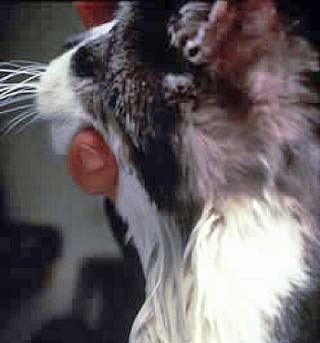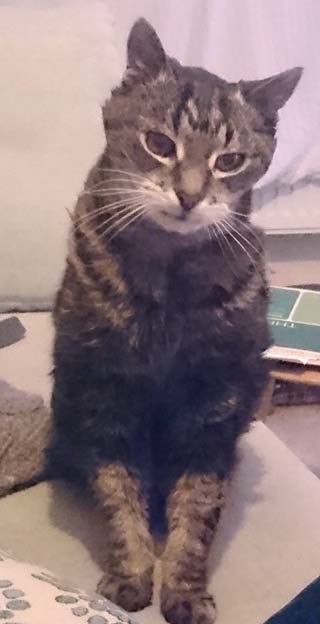23 Jan 2017
Kerry Simpson, in the first of a two-part series, outlines the nature, concurrent types and diagnostic approach to this condition.

Figure 2. Typical appearance of a hyperthyroid cat, demonstrating loss of weight, muscle tone and a poorly kept coat. Image: F Lawrence.
Hyperthyroidism is the most common endocrinopathy seen in cats. It is typically caused by hyperplasia of the thyroid gland with 1% to 2% of cases being caused by a thyroid carcinoma (Gerber et al, 1994; Edinboro et al, 2004; Peterson, 2012). The increased productivity of the gland leads to excessive concentrations of the thyroid hormones, with thyroid stimulation no longer being controlled by thyroid-stimulating hormones. It remains undetermined why the incidence of hyperthyroidism has increased since its first description in 1979. However, the increased prevalence in some countries, and not others, has led some authors to believe environmental contaminants and food may play a role in disease development. When hyperthyroidism arises, the excessive thyroid hormone concentrations increase the metabolic rate, causing an increased appetite, weight loss, a high heart rate and thickening of the heart muscle. Behaviourally, a decrease in tolerance levels and skeletal muscle weakness are seen.
Hyperthyroidism can be treated by the administration of radioactive iodide, surgical removal of the glands, medical therapy to block the formation of the thyroid hormones or feeding an iodine-deplete diet. Each treatment modality has its advantages and disadvantages, but, ultimately, the choice of treatment depends on the cat’s lifestyle, personality, co-morbidities and the owner’s finances, lifestyle and relationship with the cat.
Hyperthyroidism is a commonly recognised endocrine disorder that results in an overproduction of thyroxine (T4) and tri-iodothyronine (T3).

It is generally thought most actions of the thyroid hormones are mediated by T3 and that T4 plays a role primarily as a prohormone. Evidence for this assumption comes from the discovery of nuclear T3 receptors – but not T4 – in tissues responsive to thyroid hormone (Dillmann, 1990). The majority of actions elicited by T3 appear to take place in the
nucleus where T3 receptor proteins are located. These are members of the cellular erythroblastosis A (c-erb A) proto-oncogene family (Bahouth, 1991).
By binding to the receptors, the transcription of specific genes is affected. The type and number of genes affected is widespread – perhaps explaining the multiple changes seen in organ systems under the influence of thyroid stimulation. The effects of T3 on organs are mediated by three general mechanisms:
The aetiology of feline multinodular adenomatous goitre remains unknown. A goitre arises from the multiplication of follicular epithelial cells to form new follicles. Growth-stimulating immunoglobulins, thyroid stimulating hormone (TSH), or other growth factors already present at low concentrations, may trigger the replication of these cells.
In man it is known thyrotropin acts as a growth stimulator for normal thyroid cells, acting both directly through the cyclic adenosine monophosphate pathways and indirectly by increasing the sensitivity of thyrocytes to other growth factors, such as insulin-like growth factor one. It has also been hypothesised there may be a loss of some of the inhibitory effects of growth modulators, and the development of follicular-cell adenomas may be the result of preferential growth of cell clones (Gerber et al, 1994).
Feline hyperthyroidism was first reported in 1979 (Peterson, 2012) and although postmortem specimens prior to this occasionally demonstrated thyroid enlargement, until that time, the disease appears to have been rare. Since the first reports in 1979 and 1980 (Peterson, 2012), the incidence has risen markedly. However, the disease is more common in some countries (the US, UK, Germany and Japan) than others (Spain and the region of Hong Kong) and, therefore, it has been hypothesised continuous exposure to environmental chemicals that disrupt the thyroid or goitrogens in food and water, acting together in a synergistic manner, may account for the increase in disease incidence, and geographical variation in disease (Gerber et al, 1994; Kass et al, 1999; Peterson, 2012).
Studies assessing the lifestyle of cats that developed hyperthyroidism have proposed links to feeding an increased proportion of canned food – particularly fish, liver and giblets (Kass et al, 1999; Martin et al, 2000; Edinboro et al, 2004a, Edinboro et al, 2004b; Olczak et al, 2005; Wakeling et al, 2009) may be involved, and one study implicated pop-top lids as a cause (Edinboro et al, 2004b). In light of these findings, it has been suggested the iodine content of the food, the presence of soy isoflavones and cans lined with compounds containing the chemical bispenol A, may play a role in disease development (Peterson, 2012). More recently, the role of household contaminants has been investigated (indoor-only cats demonstrating an increased risk).
Polybrominated diphenyl ethers (PBDEs), used as flame retardants in many household products, have been demonstrated to have goitrogenic properties in humans, and can be found in high levels in cats increasing with age (Chow et al, 2014; Norrgran et al, 2015; Mizukawa et al, 2016). However, as yet, mixed reports surround the role of these contaminants in the aetiology of feline hyperthyroidism; where aged-matched populations of euthyroid and hyperthyroid cats have demonstrated similar levels in some studies, others have demonstrated altered metabolism in the cat and hypothesised that particular PBDEs might be linked to disease development (Norrgran et al, 2015; Mizukawa, 2016).
Hyperthyroidism can affect cats from 6 to 20 years old (mean age 11 to 12 years). There do not appear to be any breed or sex predilections, although, in some studies, the Siamese breed appears to be protected (Kass et al, 1999). The elevation in thyroid hormone levels affects many systems and, for this reason, clinical signs can be quite diverse. The most common reasons for initial presentation are polyphagia, weight loss, diarrhoea, intermittent vomiting, hyperactivity, polyuria and/or polydipsia. On physical examination, a palpable thyroid goitre is often noted (70% to 90% of cases; Figure 1).

Affected cats are usually thin, with reduced muscle mass, may be short-tempered, often have a raised resting heart rate, can be hypertensive and may have a systolic heart murmur (Fox et al, 1999). Routine haematology and biochemistry may show an erythrocytosis, leukocytosis with a mature neutrophilia, lymphopenia and eosinopenia, a moderate increase in alanine transferase and alkaline phosphatase, a mild hyperglycaemia and up to 30% suffer from azotaemia, which can range from slight to severe (Slater et al, 2001; Carney et al, 2016).
Diagnosis is usually made by demonstrating increased circulating levels of total T4. However, 2% to 10% of hyperthyroid cats have a resting T4 in the normal range (often due to concurrent non-thyroidal illness). In such cases, the T4 and free T4 by equilibrium dialysis (fT4ed) should be assessed. If the T4 is in the upper limit of the reference range, and the fT4ed is elevated, hyperthyroidism can be diagnosed. If, however, the T4 and fT4ed are within the reference range, causes of non-thyroidal illness, such as gastrointestinal malabsorption, lymphoma, and diabetes mellitus, should be ruled out. When no concurrent illness is identified then it may be necessary to perform a T3 suppression test, serum TSH concentration (not validated in cats, but the canine test has been used in some studies) or perform thyroid scintigraphy – where available (Carney et al, 2016).
It has been reported abnormalities of the cardiovascular system can be found on physical examination in 95% of hyperthyroid cats (Santilli et al, 2000), and most cats examined show changes similar to those seen in hypertrophic cardiomyopathy, with only occasional cases resembling dilated cardiomyopathy. For this reason, hyperthyroidism is sometimes said to cause a form of secondary cardiomyopathy. The most common alterations in the cardiovascular system are hyperkinetic femoral pulses (91.2%), systolic murmurs (44.7%), gallop sounds (31.5%) and sinus tachycardia (26%; Santilli et al, 2000).
Hyperthyroidism has been linked to systemic hypertension. While the incidence of hypertension is similar in aged-matched and untreated hyperthyroid cats, it has been demonstrated after treatment (by any modality) cats with hyperthyroidism are at an increased risk of developing hypertension.
Hyperthyroidism has numerous effects on the body, which, if left untreated, will ultimately prove fatal. However, the disease is easily treated and, with effective treatment, cats can survive for prolonged periods.